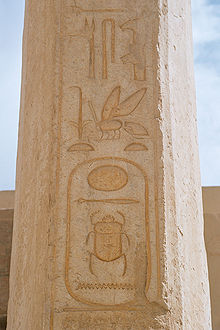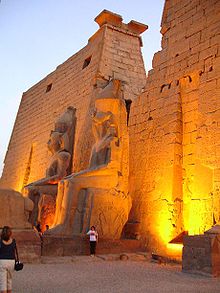Opet festival
| Opet festival in hieroglyphics | ||||||||||||||||||
|---|---|---|---|---|---|---|---|---|---|---|---|---|---|---|---|---|---|---|
| New kingdom |
Heb-nefer-en-Ipet Ḥb-nfr-n-Jp (3) t Nice feast of Opet |
|||||||||||||||||
| nickname |
Jmen-Ipet-sut-em-ipet-resit-Ipet Jmn-Jpt-swt-m-jpt-rsjt-Jpt Amun of Karnak in the southern harem of Ipet |
|||||||||||||||||
The Opet festival (also Ipet festival, Amun in his private rooms (Luxor) ) was first recorded under Queen Hatshepsut in the New Kingdom and has been one of the most important festivals in ancient Egypt since its inception .
As a festival lasting several days, the processions symbolize the cycle of the holy wedding , procreation of the royal ka , legitimation and coronation of the king and the rejuvenation of Amun-Re through the practice of the cult of the gods.
In this context, Hatshepsut saw himself as Ipet with her proper name "The first of the noble women (ladies) to hug Amun" and thus made the reference to her "divine birth" and "divine conception by Amun".
background
origin

The date of the Opet festival is related to the 15th Achet II (September 29th) 1492 BC. BC , the day of the coronation of Thutmose II. From that day Hatshepsut's mother, Queen Ahmose, took over the reign of the very young king . Subsequently, in the first year of reign, Nubian princes who had previously installed Thutmose I rebelled . On a stele that stood between Aswan and Philae , Thutmose II reported on the suppression of the revolt:
"9. Achet II: Then his Majesty sent a large army to Nubia for the first time that he undertook a triumphal march to overthrow all who revolted against his majesty (...) Then this army of his majesty threw down those barbarians. They did not let any of their husbands live, just as His Majesty had ordered, with the exception of one of these children of the Prince of Wretched Cush , who was brought alive as a prisoner with their people to the place where His Majesty was, and the was placed under the feet of the good God. "
Thutmose II later had a victory monument erected on the third cataract near Kerma on his coronation day . This special day also marked the beginning of the later Opet festival. Thutmose III. Founded the Opet Festival as a festival of the same name for Amun in Elephantine , which also began there at the same time on the evening of the 14th Achet II.
The Opet festival under Hatshepsut
The Opet festival was first held under Hatshepsut in 1462 BC. Attested for the 14th Achet II. Hatshepsut had scenes from the ceremony posted on the walls of the Red Chapel the following year . In the terrace temple of Deir el-Bahari the report can be read, which describes the "divine begetting" of Hatshepsut by Amun :
“[This glorious God came, Amon the Lord of the Thrones of the Two Lands] after he had changed into the majesty of this her husband, the King of Upper and Lower Egypt ʿ3-ḫpr-K3-Rʿ ; they found her resting in the beauty of her palace. She awoke because of the scent of God; she smiled at his majesty. Then he went to her immediately and became ardent ( ḥ3d ) against her, he gave his heart into her, he let her see him [in] his form as God after he had come before her. She was glad to see his beauty, his love entered her body, [the palace was flooded with the scent of God], all his [scents] were (scents) of Pwnt . [This God] did everything he wanted with her. She made him happy about her. [She] kissed him. "
Fixed dates
Thutmose III. returned to Karnak in the 23rd year of his reign after his victory in the battle of Megiddo in time to celebrate the divine descent of Amun as part of the celebrations of the Opet festival on the 15th day of the month P3 Jpt (Paophi) ( 15th Achet II (21. September 1457 BC ). After Hatshepsut opened the Opet festival in the previous years, Thutmose III. for the first time the procession of Amun in connection with an additional victim sacrifice regarding the victorious battle of Megiddo:
“His Majesty (Thutmose III.) Amun donated a new sacrifice to God (after returning from Megiddo) to do what is praised in his temple in Karnak on his beautiful feast of Opet on the 15th of Achet II. If the king did this marvelous God goes out to take his trip to his southern castle (Luxor), he makes a great sacrifice for this day when he moves into the southern castle as an annual achievement. "
On the evening of 14th Achet II the first ceremonies of the Opet festival began, which ended after 11 days on 25th Achet II. This date was at the latest under Ramses III. Relocated to 18th Achet II, which was followed by the first holiday on 19th Achet II. The reasons for the postponement have not yet been clarified. Ramses III. extended the festival period to 27 days when he took office. With the arrival of Amun on the 15th of Achet III, the Opet festival ended; under Ramses II with 23 holidays on 11. Achet III
On the victory stele of Pije new amendments the hard life are called because of Amun Pije on 9 Akhet I was prepared to Opet Festival . On 2 Achet III, Amun returned to the temple of Karnak. Under Psammetich I , however, his daughter Nitokris arrives punctually for the original date under Hatshepsut on the evening of the 14th Achet II in Karnak.
Fixed course
If you cross the Great Court of Ramses II today , you will reach the colonnade of Amenhotep III. The inside of the walls of the colonnade is decorated with depictions of the Opet festival, which date from the time of Tutankhamun , Ejes and Haremhab .
Accompanied by the king, as well as priests and reading priests, the statues of the gods of Mut , Chons and Amun are led on their cult barques from the Karnak to the Luxor temple. During the procession, the banks of the Nile are lined with local people who pay homage to the passing gods and the king. In the so-called birth room of the Ipet rsjt , the Mammisi , the annual ritual union of the imperial god with the royal mother takes place, followed by the birth of the royal Ka . The Ka then merges with the king, who appears again with his newborn Ka as the "son of Amun-Re" in front of the cheering festival participants on
"Place of his justification, in which he [here Amenophis III.] Is rejuvenated ( ḥwn ), the palace from which he happily steps out at the moment of his epiphany ( ḫʿw )."
With the “justification” and the “appearance” of the “good God”, as well as through the cultic regeneration of Amun-Re in his jpt rsjt , the ideal cosmic and social order is renewed, a state of salvation (...) from which people and gods, social and cosmic spheres are equally affected:
“ Rejoice, you whole country! The good time has come. A Lord - may he live, be safe and sound - has appeared in all countries, Ma'at has returned to her place. (…) The wicked have fallen on the face, the greedy are all despised. The water stands and does not run dry, the flood rises high. The days are long, the nights have hours, the moon comes at the right time. The gods are soothed and content, one lives in laughter and wonder. "
literature
- Rolf Krauss : Sothis and moon dates. Studies on the astronomical and technical chronology of ancient Egypt (= Hildesheimer Egyptological contributions. (HÄB). Volume 20). Gerstenberg, Hildesheim 1985, ISBN 3-8067-8086-X .
- Jean Meeus , Denis Savoie: The history of the tropical year. In: Journal of the British Astronomical Association. Volume 102, No. 1, 1992, ISSN 0007-0297 , pp. 40-42, ( bibcode : 1992JBAA..102 ... 40M ).
- Richard A. Parker : The calendars of ancient Egypt (= Studies in Ancient Oriental Civilization Volume 26, ISSN 0081-7554 ). University of Chicago Press, Chicago IL 1950.
- Georges Posener : De la Divinité du Pharaon (= Cahiers de la Société asiatique. Volume 15, ZDB -ID 401578-2 ). Imprimerie Nationale, Paris 1960.
- Siegfried Schott : Altägyptische Festdaten (= treatises of the humanities and social sciences class. [AM-GS]. 1950, Volume 10, ISSN 0002-2977 ). Publishing house of the Academy of Sciences and Literature, Mainz 1950.
- Peter H. Schulze: Mistress of both countries, Hatshepsut. Woman, God and Pharaoh. Weltbild-Verlag, Augsburg 1990, ISBN 3-89350-082-0 .
- Kurt Sethe : Documents of the 18th Dynasty (= documents of the Egyptian antiquity. German. Department 4 Urk IV ). Volume 1. Edited and translated. Hinrichs, Leipzig 1914 (reprint: Akademie-Verlag, Berlin 1984).
- The Festival Procession of Opet in the Colonnade Hall with Translation of Texts, Commentary, and Glossary by the Epigraphic Survey. In: The University of Chicago (Ed.): The University of Chicago Oriental Institute Publications. Volume 112, Chicago 1994, ISBN 0-918986-94-X .
Remarks
Individual evidence
- ↑ A goddess who has embodied the Temple of Luxor since the late New Kingdom: Jean-Pierre Corteggiani: L'Égypte ancienne et ses dieux. Dictionnaire illustré. Fayard, Paris 2007, ISBN 978-2-213-62739-7 , p. 240.
- ^ Siegfried Schott: Ancient Egyptian festival dates. Mainz 1950, p. 87; Certificate IV, 82.
- ↑ a b Kurt Sethe: Documents of the 18th Dynasty. Berlin 1984, pp. 68-69.
- ^ Siegfried Schott: Ancient Egyptian festival dates. Mainz 1950, p. 84; Document IV 824, 10.
- ↑ Kurt Sethe: Documents of the 18th Dynasty. Berlin 1984, p. 102.
- ^ A b Siegfried Schott: Ancient Egyptian festival dates. Mainz 1950, p. 85.
- ^ Siegfried Schott: Ancient Egyptian festival dates. Mainz 1950, pp. 86-87.
- ↑ 2 x 7 papyrus bundle columns with an open umbel capital .
- ↑ Originally at the beginning of the celebrations on land and on the way back on boats; since Tutankhamun in both directions on the Nile: The Festival Procession of Opet in the Colonnade Hall by the Epigraphic Survey. The University of Chicago Oriental Institute Publications : including panel 12 and panel 68.
- ^ WJ Murnane: Opetfest. In: Wolfgang Helck , Eberhard Otto (Hrsg.): Lexikon der Ägyptologie. Volume 4: Megiddo - Pyramids. Harrassowitz, Wiesbaden 1982, ISBN 3-447-02262-0 , pp. 574-579.
- ^ Ian Shaw and Paul Nicholson: The British Museum Dictionary of Ancient Egypt. British Museum Press, London 1996.
- ↑ Urk IV, p. 1683, lines 2-3 (architrave inscription)
- ↑ nṯr-nfr
- ↑ Jan Assmann: Ma'at. Justice and Immortality in Ancient Egypt. Beck, Munich 2001, ISBN 3 406 45943 9 , p. 221.

